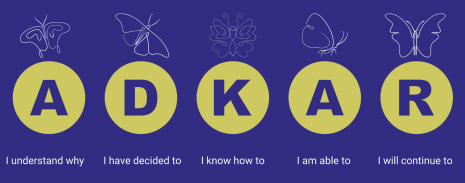Mastering Change Management: An Essential HR Strategy
Leverage the ADKAR model to build a resilient and engaged workforce
Posted on 08-23-2024, Read Time: 6 Min
Share:

Yet, in today’s fast-paced business world, change is inevitable. With new technologies, processes, and regulations emerging all the time, it’s our job to make sure these transitions are as smooth as possible for our employees. This is where effective change management becomes crucial.
Change management isn’t just about implementing a new system or policy—it’s a strategic approach that helps minimize resistance and ensures employees embrace the change. It’s about leading your team through the process of understanding, adapting to, and ultimately succeeding in the new environment.
One of the most widely recognized models for managing change is Prosci's ADKAR model, which stands for Awareness, Desire, Knowledge, Ability, and Reinforcement.

This simple yet powerful framework provides a roadmap for navigating change through five key elements:
1. Awareness: Building the "Why"
Awareness is the first step in the ADKAR model, emphasizing the importance of employees understanding the need for change and why it is necessary. Without this awareness, employees may resist change and struggle to grasp the reasons behind it. HR professionals can create awareness by clearly communicating the reasons for change, its benefits, and the consequences of not changing. Effective communication strategies, including town hall meetings, emails, and one-on-one discussions, can help convey this message and build a foundation for successful change.2. Desire: Igniting the Spark
Desire is the second step, focusing on fostering a desire among employees to engage and participate in the change. This involves addressing their concerns, involving them in the change process, and highlighting the personal and organizational benefits of the change. HR professionals play a critical role in creating buy-in and motivation, which can be achieved through employee involvement in decision-making, transparent communication, and recognizing the emotional impact of change.3. Knowledge: Equipping Your Team
Knowledge is the third step, where individuals gain the necessary knowledge and skills to implement the change successfully. Providing training, resources, and support is essential in this phase. HR professionals must ensure that employees have access to the tools and information needed to develop the skills required for the new way of working. This could include formal training programs, online resources, and mentorship opportunities.4. Ability: Putting Knowledge into Practice
Ability is the fourth step, where individuals demonstrate their ability to implement the change in their daily work. This involves putting the acquired knowledge and skills into practice, overcoming any challenges or obstacles, and actively participating in the change process. HR professionals should provide ongoing support, coaching, and feedback to help employees translate their learning into action and build confidence in their abilities.5. Reinforcement: Securing Long-term Success
Reinforcement is the final step, where organizations sustain the change and ensure its long-term success. This involves recognizing and rewarding employees for their efforts, monitoring and measuring the impact of the change, and continuously improving the change management process. HR professionals can implement recognition programs, conduct regular follow-up assessments, and create a culture of continuous improvement to reinforce the change and ensure it becomes embedded in the organization's practices.The HR Advantage in Change Management
The importance of change management for HR professionals cannot be overstated. In today's rapidly evolving business environment, the ability to effectively manage change is a critical competency for HR leaders. By using Prosci's ADKAR model, HR professionals can guide their organizations through change more effectively, minimizing resistance and maximizing employee adoption. This structured approach helps ensure that changes are implemented smoothly and that employees are supported throughout the transition.By embracing change management and utilizing the ADKAR model, HR professionals can become instrumental in creating a resilient and adaptable workforce. Remember, employees who feel supported and equipped during change are more likely to be engaged and productive and, ultimately, thrive in the new environment. So, take charge, embrace change management, and become the champion your organization needs to navigate the exciting road ahead.
Author Bio
 |
Ronita Sengupta is a Certified Change Practitioner, Corporate Communication Strategist, and the Group Chief Corporate Development Officer at GTT Solutions. |
Error: No such template "/CustomCode/topleader/category"!
